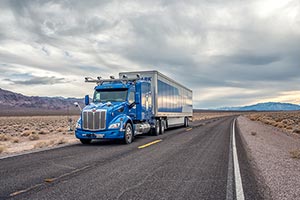Managing Editor, Features and Multimedia
Tech Startup Joins Push for Driverless Trucks

This story appears in the Feb. 27 print edition of Transport Topics.
A new technology company has joined the race to develop autonomous driving systems for commercial trucks.
Embark, a startup based in San Mateo, California, is working to build self-driving technology that would allow trucks to run on highways with no human input.
The company, which quietly began testing its system on public roads in Nevada earlier this year, was set to unveil the technology to the public on Feb. 24.
CEO and co-founder Alex Rodrigues said in an interview prior to the unveiling that Embark’s goal is not simply to assist drivers, but to enable completely unmanned trucks to travel on highways, from exit to exit, while continuing to rely on people for city driving.
“We think we can get to market quickly by limiting the scope of where it operates,” Rodrigues told Transport Topics.
Embark’s system uses onboard radar, cameras and lidar sensors in conjunction with military-grade GPS to monitor the truck’s environment and track its position. Self-driving software processes that information using a form of artificial intelligence that allows the truck to learn from its own experience, the comp-any said.
The startup is backed by Maven Ventures, which sold its previous investment in self-driving technology, Cruise Automation, to General Motors last year.
Embark’s vision for driverless trucks differs from the technology concepts espoused by truck manufacturers, which have been demonstrating driver- assist technologies that help rather than replace the human operator.
Rodrigues, however, predicted that those driver-assist systems will be “leapfrogged” by full autonomy, in part because it offers a “much stronger business case.”
A driverless vehicle that isn’t constrained by hours-of- service requirements could dramatically increase productivity, thereby offering a higher value proposition that supports a more sophisticated sensor set, he said, adding that $20,000 to $40,000 is a fair estimate for the additional hardware cost for a fully autonomous truck.
Today, Embark is using a truck retrofitted with its technology for testing purposes. But longer term, the company aims to partner with truck manufacturers and suppliers to bring its system to market.
Much work remains, however, to refine the technology and prove to the public and regulators that it is safe.
Rodrigues said his company will need to conduct significant testing, on the order of millions of miles, before running a vehicle with no one in it.
Thus far, Embark’s test truck has logged more than 10,000 autonomously driven miles on Nevada’s public roads since receiving an autonomous vehicle license from the state earlier this year, he said.
Embark said it has recruited talent from Audi’s self-driving team and plans to quadruple its engineering staff within a year while expanding its test fleet.
Rodrigues would not offer a specific timeframe for when his company’s technology would be commercially available but said he believes that day is “much closer to now than a decade from now.”
He said there’s a safety cost associated with slowing the advance of automation, given that there are about 11 fatalities a day in the United States from crashes involving heavy trucks.
“It’s important to be super safe, but it’s also important to support innovation,” he said. “We’re currently accepting massive risk by not doing it.”
While fleets might choose to deploy Embark’s technology in a number of different ways, Rodrigues said drop-and-hook operations using multiple tractors would be an ideal fit.
In that case, local drivers would pick up loads and deliver them to staging areas near highways, similar to what less-than-truckload fleets do today with hubs. From there, an autonomous tractor would haul the trailer from city to city on the highway, then drop it off near the destination, where another human-operated truck would handle the final-mile distribution.
“While you still need a person to touch every load, you can have a person do two or three loads a day instead of one load every two or three days,” Rodrigues said.
That business model could improve drivers’ quality of life by shifting their work from longhaul to local delivery, where they receive more home time.
Rodrigues said automated trucks could prevent the driver shortage — already a top industry concern — from causing America’s freight system to grind to a halt in the coming years and decades.
Embark is not the first Silicon Valley technology firm looking to bring automated driving to trucking.
Otto, founded in January 2016 by former Google engineers and acquired by Uber in August for $680 million, gained widespread attention in October when a truck equipped with its self-driving technology delivered a load in Colorado for Anheuser-Busch.
Automated-vehicle expert Richard Bishop predicted that more technology startups are likely to enter the trucking sector in the years ahead.
The passenger-car market already has been saturated by automated driving developers, he said, leaving trucking as a sort of “green-field” opportunity for Silicon Valley.
Startups entering the industry could benefit by working through trucking’s traditional channels, such as established OEMs and providers of fleet-management technology, or by partnering with a large fleet trying to gain an edge, Bishop said. “Trust and credibility is very big in the trucking industry, and it’s tough for a brand new name to break in — not impossible, but challenging.”

